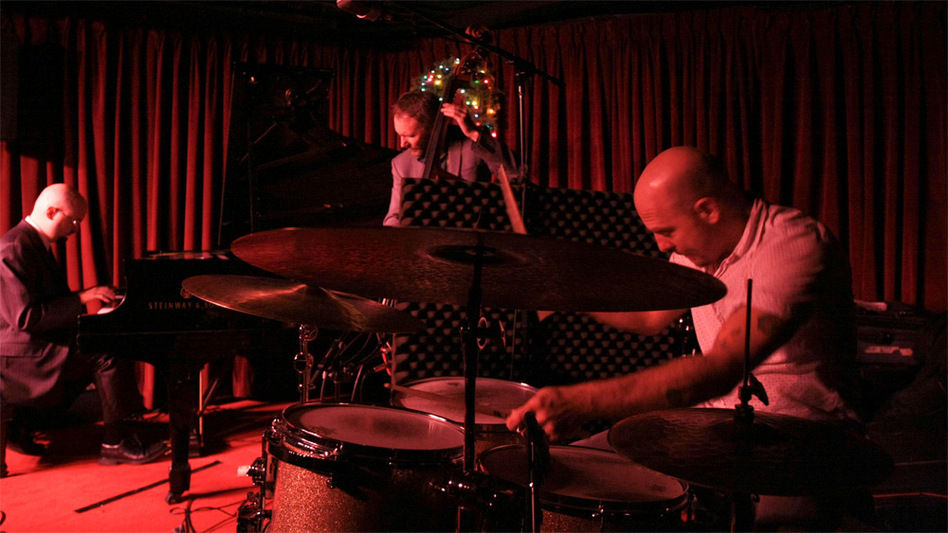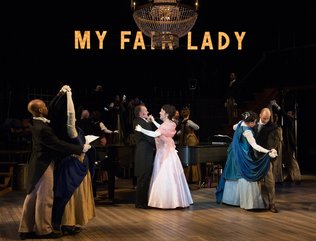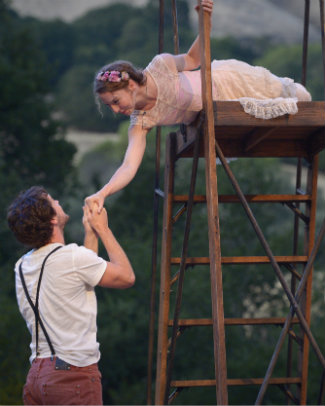I flew back to New York on Thursday, just in time to be smacked in the face by the tail end of the protracted heat wave that overwhelmed the city around the time that I headed west to San Francisco. Mrs. T had wisely retreated to rural Connecticut in an attempt to stay cool, and when I unlocked the door of our apartment and poked my head into the living room, it felt as though I were inspecting the interior of a pizza oven.
I had to run the air conditioner for a full hour before my bedroom-office become more or less livable. Still, I was home again, sleeping in my own bed and surrounded by the works of art that Mrs. T and I had painstakingly hung two weeks earlier, and that was consolation enough.
 On Friday I laid low, applying a few last editorial touches to the libretto of The King’s Man, my latest operatic collaboration with Paul Moravec, then shipping the results off to him in Rome via e-mail. I emerged at dusk to meet Ethan Iverson for dinner at a restaurant around the corner from the Village Vanguard, where the Bad Plus was playing.
On Friday I laid low, applying a few last editorial touches to the libretto of The King’s Man, my latest operatic collaboration with Paul Moravec, then shipping the results off to him in Rome via e-mail. I emerged at dusk to meet Ethan Iverson for dinner at a restaurant around the corner from the Village Vanguard, where the Bad Plus was playing.
Ethan and I met in 1999 when I was writing a piece about the Mark Morris Dance Group for the New York Times. (It’s in the Teachout Reader.) In those days he was still Mark’s music director and rehearsal pianist, but a year later he, Reid Anderson, and David King started the Bad Plus, a trio that plays what its members call “avant-garde populism (progressive, musically sophisticated ideas without the highbrow trappings).” Today they perform all over the world, most recently at California’s Ojai Festival, where the group collaborated with Mark on “Spring, Spring, Spring,” a new dance set to the Bad Plus’ trio version of The Rite of Spring.
Because Ethan and I spend so much time on the road, we rarely get to see one another. It was a rare pleasure to spend an hour chatting with him about our common interests, which include the novels of Anthony Powell (he was sitting at the bar reading The Kindly Ones when I showed up at the restaurant) and Donald Westlake (about which Ethan has written astutely and at length on his blog, “Do the Math”). I presented him with a set of bound galleys of Duke: A Life of Duke Ellington, after which we proceeded to the Vanguard, he to play piano and I to listen.
 I’ve been a fan of the Bad Plus ever since they first got together. In 2003 I reviewed their first major-label album for the Washington Post, and waxed enthusiastic about it:
I’ve been a fan of the Bad Plus ever since they first got together. In 2003 I reviewed their first major-label album for the Washington Post, and waxed enthusiastic about it:
The Bad Plus is a piano trio, one of jazz’s most familiar lineups–only Ethan Iverson, Reid Anderson and David King don’t sound anything like Ahmad Jamal or Oscar Peterson. Instead of the usual show tunes and jazz standards, they play “Smells Like Teen Spirit,” “Heart of Glass,” and weirdly tilted original compositions with titles like “Silence Is the Question” and “Keep the Bugs Off Your Glass and the Bears Off Your Ass.” Their producer is Tchad Blake, whose credits include albums by Elvis Costello, Suzanne Vega and Pearl Jam. And These Are the Vistas (Columbia), their major-label debut, isn’t just a breath of fresh air–it’s a tornado….
The Bad Plus doesn’t do cutesy watered-down covers of hit singles. Instead, they deconstruct the songs of Blondie, Nirvana and Aphex Twin with the same rigorous conceptual clarity that goes into their own originals, and their group sound–blunt, clear-cut, full of splintery dissonances and jolting musical jokes–blends jazz, rock and classical music so indissolubly as to make the differences between the three musics seem trivial.
Not at all surprisingly, traditional jazz buffs found it all but impossible to grasp what the group was trying to do, and they got a stack of uncomprehending reviews. Before long, though, the rest of the world caught up with the Bad Plus, and now they’re hugely and deservedly popular. (Their Vanguard gig was sold out.) It pleases me greatly to have known them when.

On Saturday I took in the off-Broadway transfer of Nobody Loves You, the new musical about reality TV and its discontents whose San Diego premiere I reviewed with hats-off enthusiasm last May. I met Mrs. T in Connecticut the following afternoon for the press opening of the Westport Country Playhouse’s revival of Joe Orton’s Loot. We went straight from the theater to our place in Connecticut, where we’ll be spending the next four days in comparative tranquility. Come Friday we hit the road again. Our twin destinations are the Hudson Valley Shakespeare Festival and Ontario’s Shaw Festival, where we’ll see five plays by Shakespeare, Shaw, Somerset Maugham, and Brian Friel.
For now, though, my travels are temporarily over, and though I love the flâneur‘s life, I won’t deny for a moment that I’m more than glad to be back home again with Mrs. T, where I belong.
(Last of three parts)
* * *
A music video of “Physical Cities,” performed by the Bad Plus last week at the Village Vanguard:

 Small-scale revivals of big Broadway musicals are hot nowadays. Not only are they cheaper to produce, but they allow smart directors to use their creativity to the fullest. Some of their ideas make better conceptual sense than others, however, and I had a twinge of doubt when I heard that the Oregon Shakespeare Festival had invited Amanda Dehnert to mount a miniature “My Fair Lady.” Of all the great musicals of the postwar era, “My Fair Lady” is the one that most closely resembles an old-fashioned operetta, and the spare-no-expense décor of both the 1956 Broadway production and the 1964 screen version have come to be seen as integral to its total effect. All the more reason, then, to cheer Ms. Dehnert, who has successfully wrought a radical transformation on the familiar parable of Henry Higgins (Jonathan Haugen), the haughty professor of phonetics, and Eliza Doolittle (Rachael Warren), the blunt-tongued Cockney flower girl whom he turns into a lady. She’s staged the whole thing in the style of Bertolt Brecht–and it works.
Small-scale revivals of big Broadway musicals are hot nowadays. Not only are they cheaper to produce, but they allow smart directors to use their creativity to the fullest. Some of their ideas make better conceptual sense than others, however, and I had a twinge of doubt when I heard that the Oregon Shakespeare Festival had invited Amanda Dehnert to mount a miniature “My Fair Lady.” Of all the great musicals of the postwar era, “My Fair Lady” is the one that most closely resembles an old-fashioned operetta, and the spare-no-expense décor of both the 1956 Broadway production and the 1964 screen version have come to be seen as integral to its total effect. All the more reason, then, to cheer Ms. Dehnert, who has successfully wrought a radical transformation on the familiar parable of Henry Higgins (Jonathan Haugen), the haughty professor of phonetics, and Eliza Doolittle (Rachael Warren), the blunt-tongued Cockney flower girl whom he turns into a lady. She’s staged the whole thing in the style of Bertolt Brecht–and it works. In addition to staging “My Fair Lady” in Oregon, Amanda Dehnert was supposed to do a “Romeo and Juliet” for California Shakespeare Theater, which puts on four shows each summer in its San Francisco-area hilltop amphitheater. Illness forced her to withdraw, but Shana Cooper, Ms. Dehnert’s replacement, turns out to much more than a mere substitute. She, too, has opted for lively simplicity, giving us a clean-lined, fast-paced modern-dress “R & J” in which all of the roles are played on an open stage by a seven-person cast and Shakespeare’s star-crossed lovers (Rebekah Brockman and Dan Clegg) look as though they graduated from high school last week. The tone is boisterous–Ms. Brockman’s Juliet is zany, giggly and plainly eager to get her beau into bed–and Paul James Prendergast’s techno-pop music heightens the right-this-minute atmosphere….
In addition to staging “My Fair Lady” in Oregon, Amanda Dehnert was supposed to do a “Romeo and Juliet” for California Shakespeare Theater, which puts on four shows each summer in its San Francisco-area hilltop amphitheater. Illness forced her to withdraw, but Shana Cooper, Ms. Dehnert’s replacement, turns out to much more than a mere substitute. She, too, has opted for lively simplicity, giving us a clean-lined, fast-paced modern-dress “R & J” in which all of the roles are played on an open stage by a seven-person cast and Shakespeare’s star-crossed lovers (Rebekah Brockman and Dan Clegg) look as though they graduated from high school last week. The tone is boisterous–Ms. Brockman’s Juliet is zany, giggly and plainly eager to get her beau into bed–and Paul James Prendergast’s techno-pop music heightens the right-this-minute atmosphere…. What do these plays have in common? To begin with, the “newest” of them opened 35 years ago. Three others date from the ’60s and ’70s. The rest are antiques. Today it’s inordinately hard for a straight play, no matter how good it is, to run on Broadway for more than a few months, since the first ingredient in the modern recipe for theatrical success is the presence in the cast of a movie or TV star. As soon as the star in question returns to Hollywood to resume his or her screen career, the show closes….
What do these plays have in common? To begin with, the “newest” of them opened 35 years ago. Three others date from the ’60s and ’70s. The rest are antiques. Today it’s inordinately hard for a straight play, no matter how good it is, to run on Broadway for more than a few months, since the first ingredient in the modern recipe for theatrical success is the presence in the cast of a movie or TV star. As soon as the star in question returns to Hollywood to resume his or her screen career, the show closes…. From San Francisco I flew north to Ashland, the arty mountain resort that is the home of the
From San Francisco I flew north to Ashland, the arty mountain resort that is the home of the  All that said, I can no more imagine moving to Ashland than to San Francisco, perhaps because I’ve never succeeded in scratching its surface. I don’t doubt that it’s a more complicated place than this bald description suggests, and it might be that closer acquaintance would make it more attractive to me. It wasn’t until I peeled off from the center of town and dined at
All that said, I can no more imagine moving to Ashland than to San Francisco, perhaps because I’ve never succeeded in scratching its surface. I don’t doubt that it’s a more complicated place than this bald description suggests, and it might be that closer acquaintance would make it more attractive to me. It wasn’t until I peeled off from the center of town and dined at  Instead of seeking out the company of strangers, I kept to myself, got a considerable amount of writing done, and drove up to Mount Ashland on Sunday afternoon. When I first went there in 2009, I hiked to the top of the mountain, a
Instead of seeking out the company of strangers, I kept to myself, got a considerable amount of writing done, and drove up to Mount Ashland on Sunday afternoon. When I first went there in 2009, I hiked to the top of the mountain, a